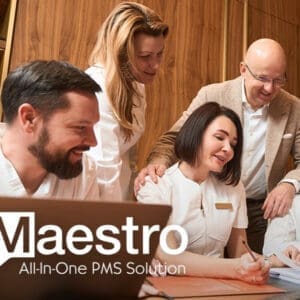 The strategy for finding success in the hospitality industry and using online dating apps is strikingly similar (believe it or not). For example, when considering marketing strategies you want to attract, convert, delight, and ultimately have a customer forever, right? Well, the same can be said when you’re looking for love – maybe not the forever part, but we’ll get to that.
The strategy for finding success in the hospitality industry and using online dating apps is strikingly similar (believe it or not). For example, when considering marketing strategies you want to attract, convert, delight, and ultimately have a customer forever, right? Well, the same can be said when you’re looking for love – maybe not the forever part, but we’ll get to that.
Whether in business or love – it all boils down to what your goals are. Do you want someone who is going to go the distance with you? Or, simply a passing fling? We’re thinking for business, you are looking for long term success. That’s why in this post, we are breaking down two popular marketing strategies and how one is like Tinder, while the other is like Match.com.
Content marketing vs advertising
Advertising, in today’s comparison, is likened to Tinder. The goal is to blatantly promote and draw attention to the service(s) or good(s) one is selling – while it does have a fairly long and colorful history in our society. Advertising strategies are pulled-together and slick, essentially it’s your “magazine smile”. It’s can be hard to show how well-rounded you are through just an ad.
There’s always a time and place for advertising, but it’s not the only method to put your message out there. This is where content marketing comes into the picture.
Content marketing can be best compared to Match.com – it’s more than a fling. Content marketing is a marketing strategy that emphasizes building relationships through creating and distributing useful, relevant and valuable content. You’re using all you have (not just your looks) to develop a long-term relationship.
Definitions are vital, but let’s highlight some clear examples to further explain the main differences between content marketing and traditional advertising, and how they specifically pertain to the hospitality industry.
Show not tell
Advertising is about telling an audience a message. Content marketing is about showing audiences what your message means and how it will solve a problem or provide a needed service.
Any marketer in the hospitality industry can talk, talk, talk all day at its audiences, but the organizations that successfully show what they can do are the ones that ultimately win.
How often do you see, read or hear advertisements claiming to be “the best” at something? Claiming to have the “lowest rates,” “comfiest beds” or “most delicious food.” How often do you yourself believe that message? Right, not often.
The audience’s have been saturated with those types of messages and many are no longer receptive to them.
Your messages have to be authentic, and they have to show. The content has to be relevant to your audience, and it has to come from the heart – seriously.
Audiences have become wise to the tricks that have been used the past few decades, and they no longer wish to receive those messages. A receptive audience is key for promoting any message, and the most receptive audiences will be those you are trying to genuinely help solve a problem for.
Show how you will solve a problem. For instance, many of your guests are vacationing families looking for a hotel that is close-by to all of the attractions, is kid-friendly and an expert in local tourism.
Rather than saying those things outright, your hotel’s content marketing team can post a blog on the website detailing the top 10 most underrated or unknown attractions in the area, and then promote the blog across social media channels. Each of the 10 attractions can be attractions kids love that are relatively close to the hotel. In one blog your hotel has displayed that it’s close by to the fun, aware of and knowledgeable about the interests of children, and a clear expert on local tourism.
Commitment instead of a fling
Content marketing requires relationship nurturing. Hoteliers and their respective teams are already aware of the importance of return customers and the impact they make on the bottom line. Well, content marketing helps attract, acquire and nurture those return customers. It’s all about building a relationship – which always takes time, but is very effective in developing deep and meaningful relationships with your guests and groups.
Advertising throws a message out there, or a one-liner shall we say, and hopes it sticks. Think back to the last time someone threw you a one-liner… did it stick? Maybe, maybe not. Works sometimes and not other times. Even if audiences go for the advertising bait, there’s a strong chance they won’t be return customers. Once the fling ends it’s simply over.
Content marketing utilizes tools such as social media to build relationships with the audience. Relationships are a two-way street, so rather than spitting out the sales message, content marketing seeks to listen, to ask questions, find out what problems the audience has so we can later solve it for them. Content marketers are showing their commitment to the audience, and when the audience feels that commitment they become return customers.
Personal rather than impersonal
Typically speaking, advertising is a message meant for a huge audience. Unfortunately it’s not possible to adjust the big advertisement to suit the specific needs of the different people within the audience.
Which is exactly where content marketing comes in. Rather than deploying a picture of a generic white family of four at the beach across all of the advertising channels, content marketing gets more personal.
Early on in the content marketing process the hotel’s audiences have been clearly defined. Meaning there is a guest persona for each type of guest. Included with that persona are details on the types of messages that resonate with the persona, and the needs of each persona.
Armed with that crucial information, content marketers can curate the appropriate message for each individual persona, and deploy those message on the fitting channels.
Think about it, your hotel likely has a variety of guests – young couples, families, LGBT community, wedding parties, meeting business, staycationers, etc. etc. Each of those groups has different needs and it’s your job to discern the differences to host them as flawlessly as possible.
Even before you get to the hosting stage, it’s your job to discern what they need – need to know, need to decide, need to have, need to do – and how you can meet those needs for them.
Develop a downloadable guide that details the best strategies for hosting an engaging meeting experience, for example. Over time develop social media posts related to meeting business that will drive your meeting audiences to your site to check out the downloadable (free) offer. To get the offer, an email was entered. Now you have a high-quality lead you can nurture into eventually becoming a customer, and likely one that stays loyal for years to come.
This isn’t to say there’s no need for advertising. Advertising has a time and a place. As detailed throughout, content marketing works in more specific and detailed ways, and is crucial for asserting your property as the property who cares, listens and problem solves.
So, do you want your marketing to be more like Tinder or Match.com? Your value lies in your ability to make life easier for people. Do that, and you’ve won. Truly help and nurture your audience and your bottom line will thrive. Utilize content marketing to reach the fullest potential imaginable.
About the author
Cory Falter is the Chief Creative Officer at Lure Agency .
.















